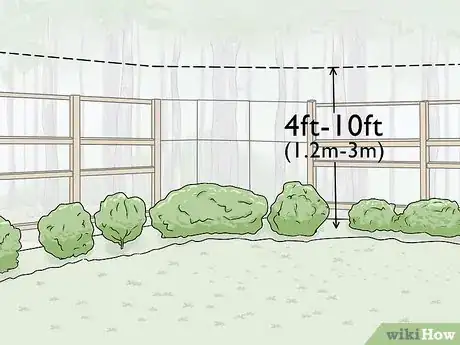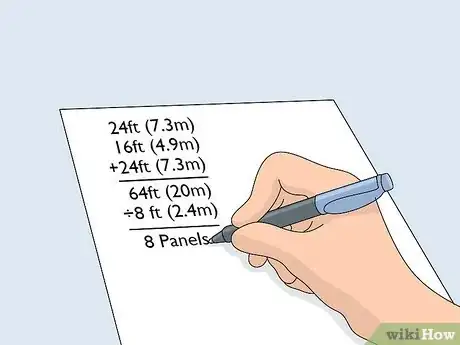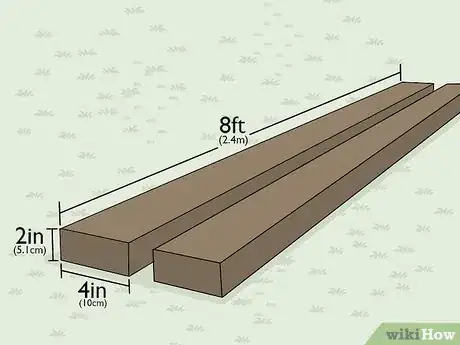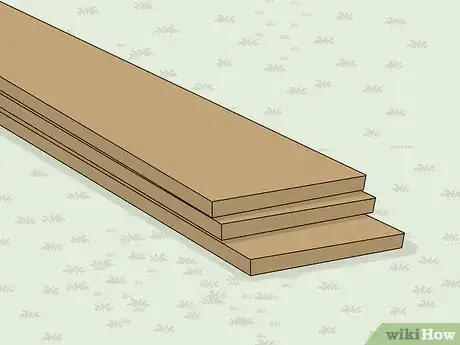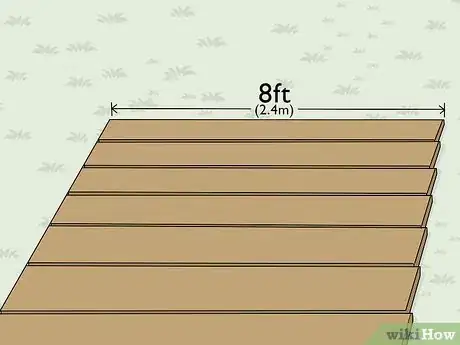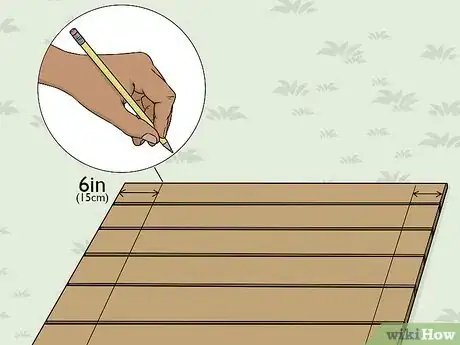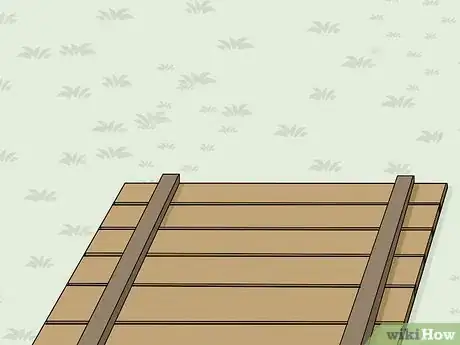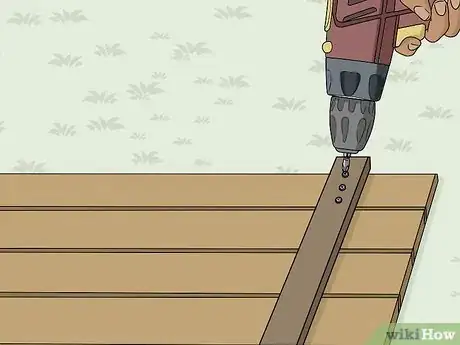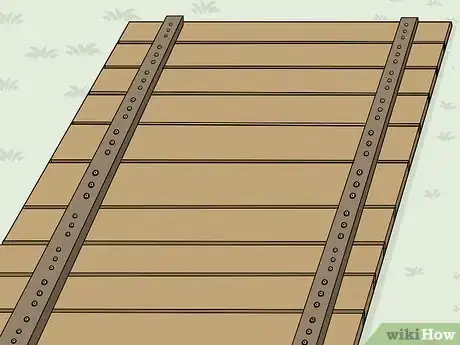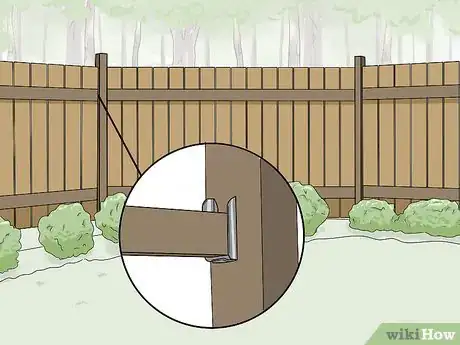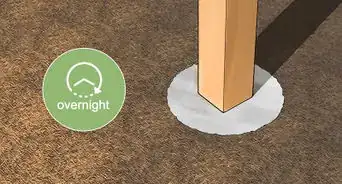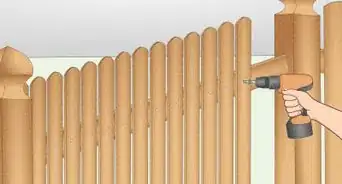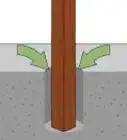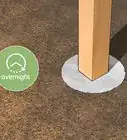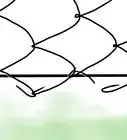This article was co-authored by wikiHow Staff. Our trained team of editors and researchers validate articles for accuracy and comprehensiveness. wikiHow's Content Management Team carefully monitors the work from our editorial staff to ensure that each article is backed by trusted research and meets our high quality standards.
There are 7 references cited in this article, which can be found at the bottom of the page.
This article has been viewed 42,933 times.
Learn more...
Fence panels are short sections that make building a fence easier. Rather than constructing the entire fence one board at a time, build the panels then attach them to the fence posts. Panels are usually pre-made and available at hardware stores, but you can save a lot of money by building your own. First, plan the length and height of your fence to determine the right materials. Then measure and cut the wood carefully. Attach the vertical boards to the horizontal rails to assemble each panel. Then repeat the process until you have enough panels to construct your fence.
Steps
Using the Right Materials
-
1Make your fence between 4 ft (1.2 m) and 10 ft (3.0 m) tall. Fences range from 4 ft (1.2 m) on the lower end to nearly 10 ft (3.0 m). The height depends on your intended use for the fence. Make privacy fences taller to shield your property from onlookers, or build a short fence to keep small pets in. Consider your intended use for this fence to decide the ideal height.[1]
- Make a privacy fence at least 6 ft (1.8 m)-8 ft (2.4 m) high to hide your property from others. Consider how much property you have to cover to decide a height for a privacy fence.
- Fences that are purely decorative or meant to keep in small pets can be 4 ft (1.2 m) high instead. Some decorative fences are only 3 ft (0.91 m) tall.
- Find out if there are any necessary permits and applications for fences in your area before you start construction. Some areas, for example, require permits for fences over 6 ft (1.8 m), or entirely prohibit fences over 10 ft (3.0 m). Check with your local zoning boards to find out if there are any regulations like these.
-
2Calculate the length of the planned fence to determine what materials you need. The fence’s length determines how much wood you need. Decide where you’ll place the fence and what it will enclose. Then use a tape measure and take the measurements for each side of the fence.[2]
- Make your fence panels 8 ft (2.4 m) long each, so divide your measurements by 8 to figure out how many panels you need to cover this area.
- For example, if your fence extends 24 ft (7.3 m) back, 16 ft (4.9 m) to the right, then another 24 ft (7.3 m) forward, that’s 64 ft (20 m) total. Divide that by 8 ft (2.4 m) and you see that you need 8 panels to complete this fence.
- Make sure you don’t build the fence over your property line. If you aren’t sure where your property line is, bring in a surveyor to mark it for you.
Advertisement -
3Get 2 2 in (5.1 cm) x 4 in (10 cm) rails for each fence panel. The 2x4s form the rails, or horizontal supports, of the panel. Choose rails that are 8 ft (2.4 m) long so they match the length of each panel. Each panel needs a top and bottom support to prevent it from sagging, so get two 2x4s for each planned panel.[3]
- If your fence will be over 8 ft (2.4 m) tall, use a third 2x4 in the center of each panel to prevent your fence from sagging.
- Only get pressure-treated wood to prevent rotting.
- For smaller fence panels, you can also use 6 ft (1.8 m) or 4 ft (1.2 m) sections. Buy or cut the 2x4s as needed for smaller sections.
- Don’t plan fence panels longer than 8 ft (2.4 m). Long panels will sag under their own weight.
-
4Select hardwood fence boards to make the panels. The boards are the vertical parts of the fence panels. There are many board styles that you can use for your fence. Depending on the wood type, boards come in different colors. They also have different decorative top shapes that give your fence a unique character. Look at sample boards at the hardware store and decide which one you want for your fence.[4]
- For a very simple fence, plain wood boards like 1 inch (2.5 cm) x 6 inches (15 cm) will do the job.
-
5Measure the width of the boards to determine how many fit in each panel. Depending on the length of your panel and the type of board you get, a different number of boards will fit on each panel. Measure the width of the board you’re using and divide that number into the length of each panel. Then multiply that result by the number of panels in your fence. Buy this number of boards for your fence.[5]
- For instance, if a board is 6 in (15 cm) in width and you’re building an 8 ft (2.4 m) panel, then 16 boards fit on each panel. If your fence will be 8 panels, then buy 128 boards.
- Take into account if the boards will all touch or if you’re leaving space between the boards.
Assembling the Panels
-
1Cut the fence boards to the correct height if necessary. If the fence boards you bought weren’t pre-cut to the height you want, use a saw and cut them yourself. Measure the height that you want each board to be, then mark where you have to cut on the board with a pencil. Cut on that line with a power saw. Repeat this process for each wood board you use.[6]
- If you’re building a 4 ft (1.2 m) fence and the boards you bought are 5 ft (1.5 m), then measure 4 ft (1.2 m) down from the top of the board. Mark that point and cut there.
- Wear gloves and eye protection when using a saw. Keep your fingers away from the blade while it’s in motion.
-
2Arrange an 8 ft (2.4 m) section of boards face-down on a flat surface. If you haven’t already, calculate how many boards will fit on each panel by dividing the width of 1 board into 8 feet (2.4 m). Then lay that number of boards face-down on a flat surface. Arrange them so the tops and bottoms line up and the boards are straight.[7]
- Working on a flat surface is important so all your materials remain straight. Don’t work on grass or a similarly uneven surface. Use a carpenter table or sawhorse to assemble the panels.
- If you don’t have a sawhorse or carpenter table, a flat driveway will work as well.
-
3Draw 2 lines across the boards 6 in (15 cm) from the top and bottom. Use a ruler and measure 6 in (15 cm) from the bottom and top of each board. Make marks on each board at this point. Then use a yardstick to connect these points with one long line across all the boards.[8]
- If there are designs on the top of the fence that extend greater than 6 in (15 cm) down, draw the line 2 in (5.1 cm) below where the design ends. This allows the fence decoration to show above the rails.
-
4Line up the horizontal rails with the lines you drew. Take one 2x4 and lay it across the bottom section of the panel. Line up the bottom of the wood with the line you drew. Then lay the second 2x4 across the top of the panel. Line up the top of this rail with the line you drew.[9]
- Double-check to make sure the rails are even with the lines you drew. Otherwise, the panel will be crooked.
-
5Screw the rails to each board. With all the boards and rails lined up, take a power drill and drill screws through the rail into each fence panel. Use 3 screws at the top and 3 screws at the bottom of each board. Work your way down the rails until every board is attached.[10]
- Re-check the rail alignment after every few boards. Sometimes the boards can shift while you're drilling. Rearrange any boards that come out of place so the panel is straight.
- If you don’t have a power drill, you can also nail the boards down. The job will be much more time-consuming if you choose this option.
-
6Repeat the building process until you have enough panels. Once you’ve completed one board, the rest of the process is just a matter of repetition. Lay out your boards, draw guidelines across them, align the rails correctly, and screw them down. Continue until you’ve built all the panels you need for your fence.
- Always measure carefully before attaching any boards. Stay alert so all your boards are in line with each other.
-
7Attach the panels to the fence posts. Install your fence posts, then secure the completed panels to them. Attach 2 brackets onto each side of a post. Then slide a rail through each bracket. Fasten the rails to the brackets with screws. Repeat the process to install each panel and complete the fence.[11]
- Fence panels are heavy, so have a friend or family member nearby to help lift them into position.
Warnings
- Always wear protective gear when using power tools. Protect your eyes with goggles and prevent cuts with thick gloves.⧼thumbs_response⧽
References
- ↑ https://www.nolo.com/legal-encyclopedia/fences-neighbors-faq.html
- ↑ https://www.popularmechanics.com/technology/a21189/how-to-build-a-fence/
- ↑ https://www.homedepot.com/c/ah/how-to-build-a-fence/9ba683603be9fa5395fab90a485b4ce
- ↑ https://www.popularmechanics.com/technology/a21189/how-to-build-a-fence/
- ↑ https://www.popularmechanics.com/technology/a21189/how-to-build-a-fence/
- ↑ https://youtu.be/7bUim9ttR3A?t=280
- ↑ https://youtu.be/7bUim9ttR3A?t=314
- ↑ https://youtu.be/fIIuhlcqSE0?t=256
- ↑ https://youtu.be/7bUim9ttR3A?t=314
